Knowing about pests is important because pests cab damage large numbers of your plants.
Plants can be damage at any stage of their growth and when they are being stored. Pests cause the loss of one-third of all the food produced in the world.
The circle shows all the food produced in the world in one year.
This amount of food is destroyed by plant pests.
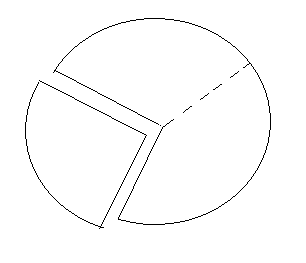
What Pests Are
Plant pests are animals that feed on plants. Most pests are insects but other animals such as snails, birds, rats and monkeys also damage plants. You can easily see insect pests such as grasshoppers, beetles, aphids and caterpillars. Other pests, such as red spiders, are very small and look like specks of red soil on the back of leaves. Nematodes, which are tiny worms that attack the roots and some types of mites are so small that you only see them with a microscope.
All pests are divided into 6 categories:
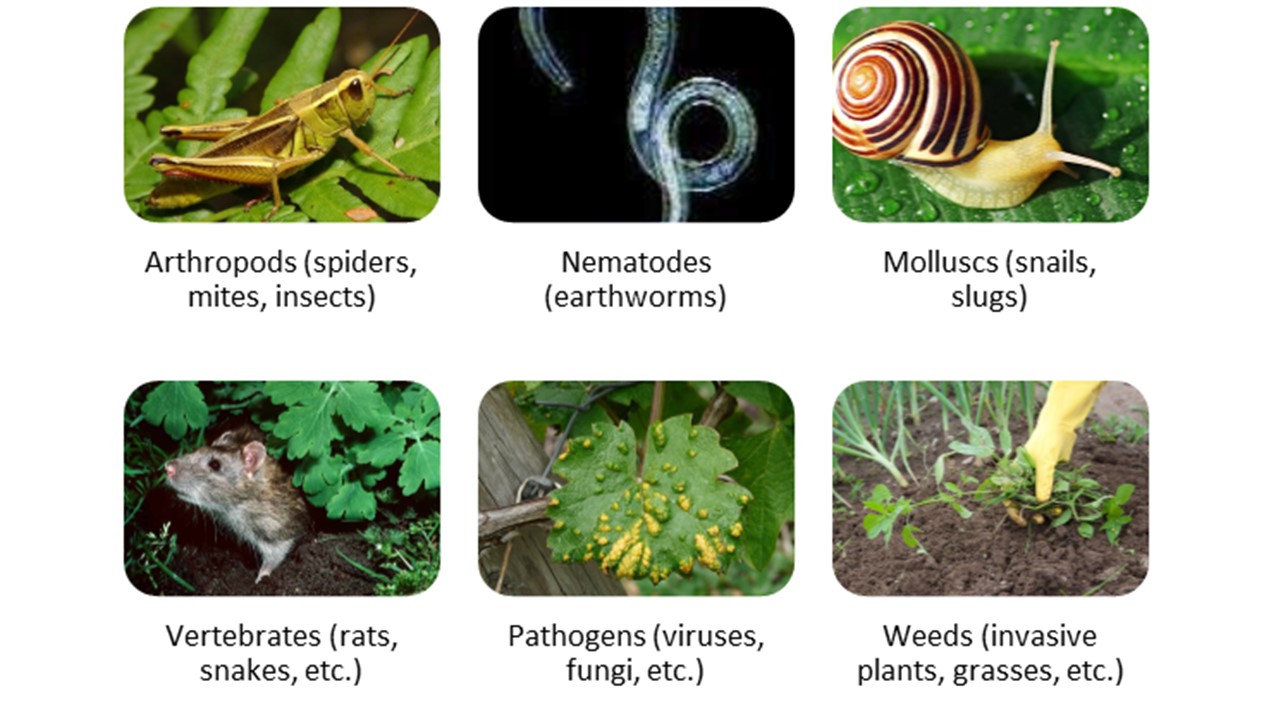
Insects multiply by laying eggs. They can have three or four stages in their life-cycles. A life-cycle is the time from when an egg hatches until the next eggs are laid. Knowing about the life-cycle of a pest can help you to control it.

The Damage Pests can Cause to Plants
Insects damage plants when they feed. Some pests feed on only one type of plant. For example, the larvae or caterpillars of the citrus swallowtail butterfly feed only on citrus such as oranges, lemons and naartjies. Other pests feed on many different types of plants. For example, the larvae of the Mediterranean fruitfly feed on citrus, mangoes, coffee, litchis, guavas, peaches, grapes, granadillas and may other types of fruit. When you see small worms in a fruit, they are usually fruitfly larvae.
The damage that plant pests do to plants depends on the way that they feed. Insects feed in one of two ways - either they chew, or they suck.
The types of damage that chewing or sucking insects cause are given below. You can use this information when you see that damage has been done to some of your plants and you want to find out what is causing the damage.
Chewing Insects
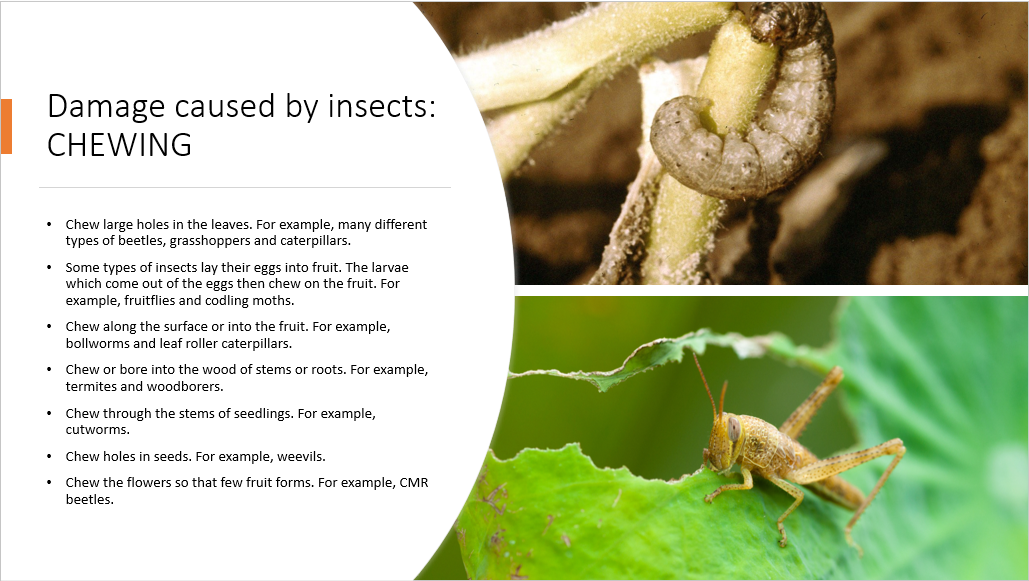
Sucking Insects

Click here to view a video that explains chewing and sucking pests.
What Pests Do To Plants

Identification and management of insect pests in crops is a specialized and difficult process. Those mentioned above are but a few of the thousands of potential pests associated with crops. As such, it is important to seek advice from a knowledgeable farmer or pest management expert to help you in planning a pest management strategy.
Click here to view a video that explains swarm of Locusts devour everything in their path.
Insect Pest Management
Insect pest Management can be done through various methods. A system, by which the different methods are integrated, is known as integrated Pest Management (IPM). Insect management methods are discussed below.
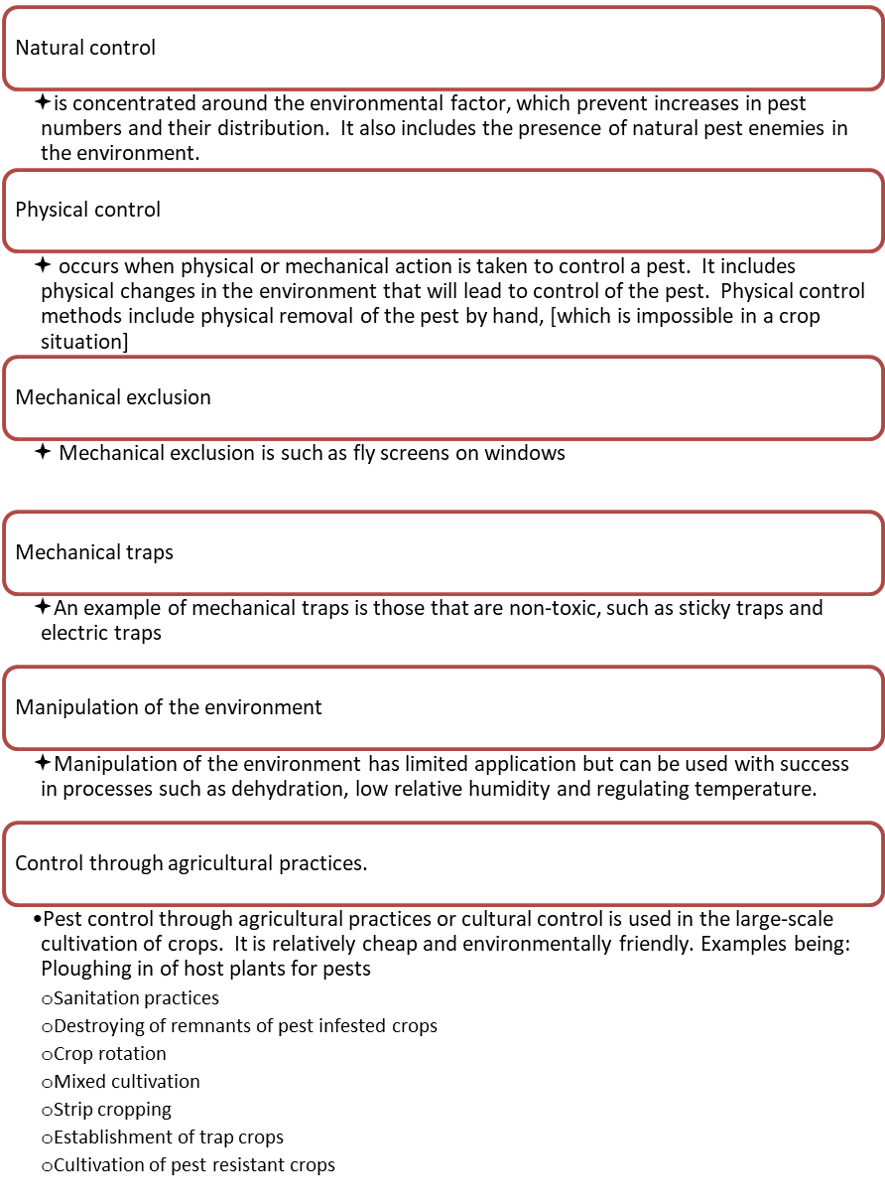
Biological Control
Biological control is the manipulation of pest enemies such as parasites, predators and pathogens in such a way that pest numbers are reduced. Biological control agents for pests are specific to a pest species, and once established, can increase and spread independently, making the control self-perpetuating. The control is however expensive, slow and the pest cannot be eliminated even for short periods of time.
Plant pests are all parts of their own food chains and food webs. There are many animals that eat the pest animals which eat crop plants. These pest-eating animals, which we call predators or natural enemies, help t keep pest numbers down. Spraying with chemical pesticides kills the natural enemies as well as the pest insects. Examples of natural enemies of plant pests are lizards, chameleons, insect-eating birds including chickens and ducks, ladybird beetles and larvae, praying mantises, spiders, wasps and some fly larvae. Some wasps lay their eggs into the larvae of pest insects.
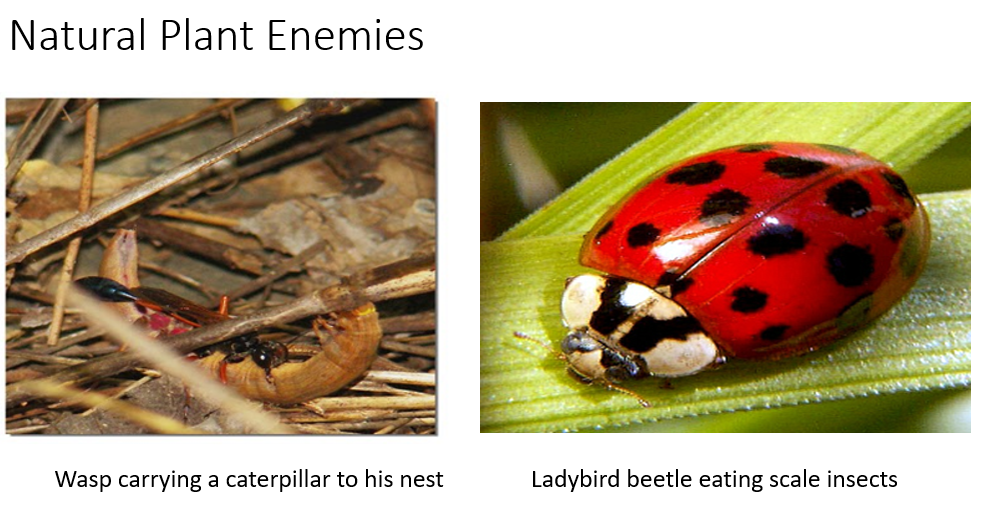
Click here to view a video that explains fighting agricultural pests, the natural way.
Click here to view a video that explains biological pest control.
Genetic Manipulation
Genetic manipulation of the pest or the crop plant can be employed as a pest control strategy. The release of sterile male pest insect into a normal population has been shown effective in parasitic fly pests in Central America. Sterilisation can be achieved through radiation of chemicals. The process is however expensive.
Manipulation of the genetics of crop plants can produce pest resident crops. This can be achieved by producing a plant that will repel the pest, or the production of a crop that produces toxic compounds. An alternative is a crop plant where growth is stimulated through insect attack, the crop thus compensates for the losses due to the pest.
Click here to view a video that explains GMOs.
Chemical Pest Control
Chemical pest control is done by using pesticides. The term pesticides refer to the wide spectrum of agrochemicals used in plant protection. Pesticides include:
- herbicides (plant or weed killers),
- insecticides,
- rodenticides (rodent killers),
- avicides (bird killers),
- molluscicides (snail killers) and
- acaracides (mite killers).
Insecticides are classified in three major groups according to their mode of action:

Contact insecticides enter the insect primarily through the exoskeleton and do not penetrate the leaves and are not translocated through the plant, whereas systemic insecticides must be taken in through feeding. The compounds are taken up by the plant and translocated throughout the plant. Insects with sucking feeding habits are the primary targets of systemic compounds. Stomach poisons must be ingested and is absorbed in the stomach of the insect. Fumigants are pesticides in a gas form and enter the insect through the respiratory system. Pesticides with trans-laminar action, penetrate the leaves of plants, but are not translocated through the plant.
Click here to view a video that explains knapsack spraying cabbage.
Pesticide Formulations
The first step in the production of a pesticide is the production of the chemical compound, which has insecticide activity. This compound is known as the active ingredient (a.i.). For the compound to be effective it must be applied to a crop field. Even older compounds are applied at relatively low rates, e.g. 1 kg spread over one hectare (10 000 m2). It is impractical to apply a pesticide as technical material, and an easier way of distributing a pesticide is diluted in water or in a powder. Often the active ingredient is not soluble in water, but the compound is formulated in such a way that it can be diluted in water and then applied. A pesticide formulation is made up of the active ingredient, solvents that aids in water solubility or water miscibility, inert additives and adjuvant (compounds that aim uptake of an active ingredient). The relative amount of a.i. in the formulation is indicated on the label as a percentage (g a.i. per 100g or 100 ml).
Pesticides are available either as dry– or liquid formulations.
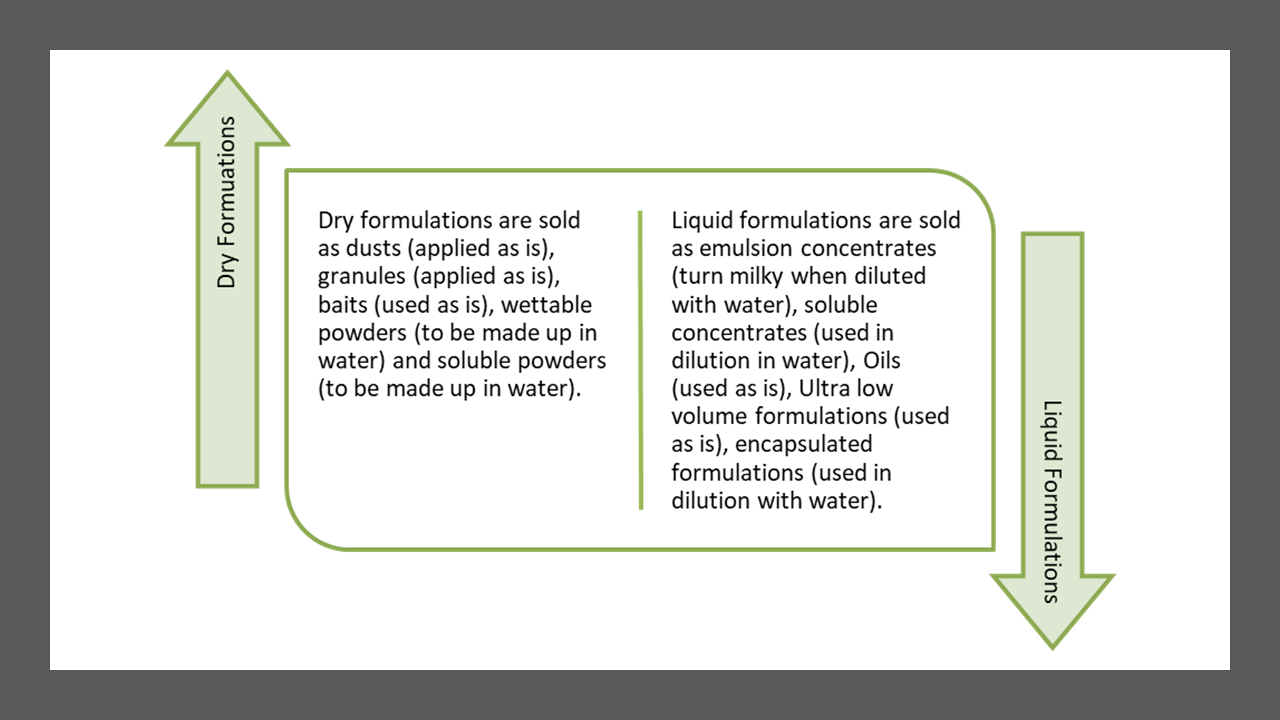
Why Pests Should be Monitored
In order to prevent crop damage from insects and diseases it is essential that crops are inspected regularly. These inspections could be done in conjunction with inspections for weed densities, diseases and crop nutrient and water status. Crop monitoring indicates the pest’s and disease status of the crop. In this way the crop producer remains informed of the health status of his crop. Information on the crop disease and pest status enables the farmer to make decisions on whether control actions need to be taken and to select a suitable control action when necessary. The farmer can now apply a once-off chemical crop treatment instead of sticking to a strict spraying programme. In this way the amount of pesticide applied and labour inputs can be reduced, thus reducing crop production costs. Some kinds of insecticides and fungicides/bactericides can even be mixed during the same spray action.
Pest to Beneficial Ratios
Pests attack crops because it is a food source to them. Under balanced conditions, the pest population will likely be balanced by a population of other predator insects or animals. As the predator population decreases, the pest population increases, as well as the extent of crop damage. Pesticide treatments will have to be applied in such cases. In a balanced system the natural predators will pressurise the pest populations, thus preventing pesticide treatment.